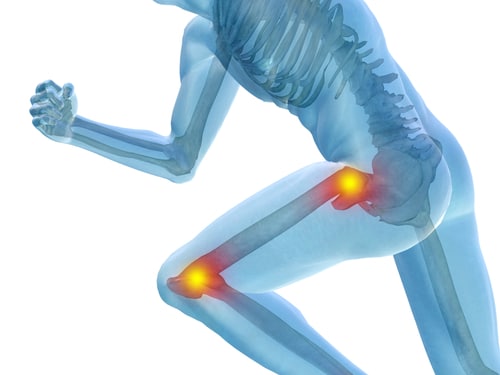
The most common form of arthritis is osteoarthritis. Osteoarthritis is very common although not everyone has symptoms with it. Still, osteoarthritis can cause achy joints that make it hard to get out of bed in the morning. In fact, the chance of developing arthritis that’s painful over a course of a lifetime is 45%. Those aren’t very good odds.
Unfortunately, people who have achy joints are often reluctant to exercise, mainly because they think exercise will make their symptoms worse or it’ll increase the progression of their joint disease. Is there any truth to this?
Exercise, Achy Joints and Arthritis
Contrary to popular belief, exercise has significant benefits for people who suffer from achy joints due to arthritis. In one study published in the Journal of Rheumatology, a group of people with osteoarthritis of the knees took part in a 16 weeks program of strength training that included squats and lunges. (Exercises that people with arthritis often avoid) At the end of the study, the participants that strength-trained had better functional fitness and a 43% average reduction in pain. Plus, it improved their overall quality of life.
The reality is LACK of exercise can worsen joint pain. People who have arthritis usually feel stiff in the morning. That stiffness is somewhat relieved by walking around and comes back with sitting for a prolonged length of time. This is called the “gel phenomenon” and is common in people with arthritis. So lack of exercise and prolonged sitting worsens joint stiffness. Plus, when you don’t use your joints it reduces their function. It’s another example of “use it or lose it.”
What about people who have joint pain due to rheumatoid arthritis, an inflammatory form of arthritis? A recently published study showed women with rheumatoid arthritis experienced reduced joint pain after cycling on a bicycle. According to the American College of Rheumatology, people with arthritis that exercise have less joint pain, sleep better, have more energy and function better during the day. Still, think exercise doesn’t help achy joints?
Strength Training for Healthier Joints
If you have achy knee joints due to arthritis you might be tempted to skip the squats and lunges. Don’t be so quick to think you shouldn’t do them. According to the American College of Rheumatology, weak quadriceps muscles increases the risk of developing more disabling arthritis symptoms. It also increases the odds of developing osteoarthritis in the first place. Of course, it’s important to use impeccable form when doing these exercises if you have knee arthritis.
How does strength training help? Strength training benefits joints in a few ways. Stronger muscles give your joints better support, protection and stability. In addition, strong muscles act as shock absorbers to absorb the stress placed on them when you walk around. It also helps with weight control. That’s a good thing since being overweight places more stress on already painful joints. In the Framingham Osteoarthritis study, researchers found a weight loss of only 11 pounds improved joint pain by 50%.
In one study a group of people with rheumatoid arthritis took part in a two years strength-training program. By the end of the study, they had experienced significant improvements in joint pain and stiffness along with reduced disease activity. Strength-training is good for rheumatoid arthritis and osteoarthritis.
Flexibility
Flexibility training is also an important part of training if you have achy joints due to arthritis. Flexibility exercises, including range-of-motion and stretching exercises, reduce joint stiffness and help to improve joint and muscle function. In addition, small studies show yoga is a beneficial form of exercise for people with joint aches and pains. Yoga increases flexibility and is a relaxing form of exercise that has psychological benefits for arthritis sufferers. A study published by the Arthritis Foundation showed yoga reduced joint swelling and pain in people with rheumatoid arthritis.
What about aerobic exercise? That’s important too. People with rheumatoid arthritis are at greater risk for heart disease, and aerobic training can lower that risk. As long as you’re not having significant pain, a study showed high-intensity exercise is safe. What about high-impact exercise? If you have arthritis, check with your doctor before doing exercise that requires lots of jumping or impact. There are still ways to do a high-intensity workout without impact. A high-intensity, low-impact step workout or a spin class will give you a heart-pumping aerobic workout without jarring your joints.
The Bottom Line?
Exercise really can make achy joints feel better while improving overall joint function. Contrary to popular belief, exercise isn’t bad for your joints. It makes them feel better and function better. Don’t let achy joints keep you on the sidelines.
References:
Centers for Disease Control and Prevention. “Arthritis”
J Rheumatol. 2001 Jul;28(7):1655-65.
Pain Pract. 2014 Feb 17. doi: 10.1111/papr.12181.
American College of Rheumatology. “Exercise and Arthritis”
Johndavid Maes, M.S. and Len Kravitz, Ph.D. “Training Clients With Arthritis”
Arthritis Foundation. “Yoga Helpful for Rheumatoid Arthritis”
J Aging Res. 2011; 2011: 681640.
Science Daily. “Dangerous connection between rheumatoid arthritis, heart disease”
Related Articles By Cathe:
What’s the Best Type of Exercise to Prevent Knee Osteoarthritis?
Tips for Exercising with Arthritis
How Your Joints Age & What You Can Do to Slow It Down
Dieting to Lose Weight May Endanger Bone Health

